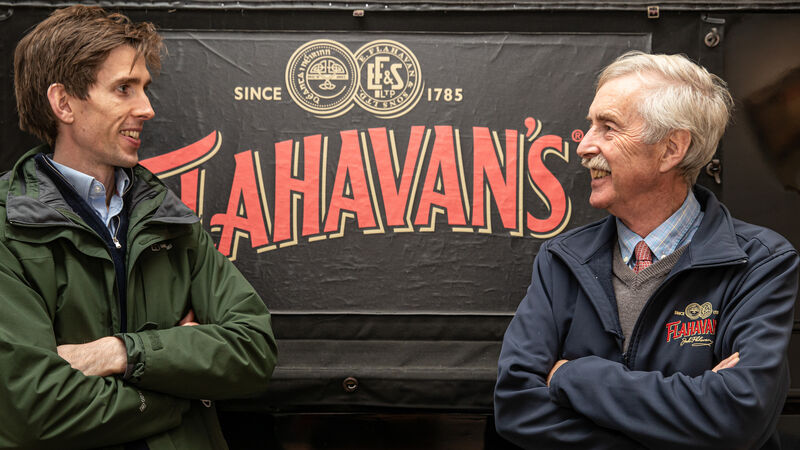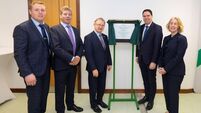Water, solar and... oat husks - The Flahavan's recipe for running its porridge operations

Johnny (left) and John Flahavan in front of the company’s vintage delivery van. On the firm's use of renewables John Flahavan Snr said: “I think we’re doing pretty well as we're going at the moment. But (we could go) probably a bit further on solar." Photo: Neil Michael
Their name may well be synonymous with porridge oats and toasty granola.
But, now Flahavan's is gaining a name for itself from something else entirely: sustainability. And it’s something current MD John Flahavan started practising long before renewables and sustainability become as common in conversation as they are now.
Indeed, he is carrying on from a tradition of using renewables practised by his ancestors for centuries. The company’s mill stream, which was dug out by hand more than 200 years ago, was always used to power the mill wheel.
It has been replaced by a water turbine, which was purchased in 1935, but which has since been upgraded with a modern generator and controls to provide green electricity to the plant.
The water turbine contributes approximately 3% of electricity requirements to assist with powering the mill and saves the company about €8,000 annually, based on 2020 energy costs.
CLIMATE & SUSTAINABILITY HUB

At Flahavan’s, they kiln the oats with the outer husk on and the husk is then removed and burned to power the boiler, which generates the heat and steam required for during the milling process. All of the heat requirements used in the mill come from this boiler, using approximately 960 tonnes of oat husk annually to fuel it.
The first oat husk boiler was introduced to the plant in 1985. Before this an oil-fired boiler was in place and the oat husks were used as an ingredient in animal feed, which was a key strand of the Flahavan’s business until the 1990s.

The company feeds the oat husks - the outer shells from the 1,666 tonnes of oats milled each month - into the boiler each month, which is equivalent to 4.25M kWh per year. If they had to use diesel to fire the boiler, they would have to pay out €300k per year.
In 2017, they installed solar panels on the roof of their grain store with a nominal rated capacity of 130 kW and this generated 110 MWh in 2020. All new replacement lights have been upgraded to LED and they are currently in the process of replacing older light fittings with these highly efficient bulbs.
The oats for the company’s Progress Oatlets are sourced from local farmers within a 60-mile radius of the mill in Kilmacthomas, some of whom have been supplying for generations. The company’s annual electricity requirements are 2.4M kWh, which is about as much energy as a village of around 580 houses.
To meet this demand, the firm produces 1.6M kWh from its wind and water turbines and its solar panels.

The solar panels, which are laid out across the roof of the grain store, cost the company initially €100,000 and were installed by Waterford firm Enerpower.
The solar panels have a rated capacity of 130kW of energy and generated 110mW of energy in 2020. They save the company around €13,000-a-year in energy bills.

The 500 kW wind turbine, which was bought second-hand from Germany in 2015, cost around €600,000 to buy and install. As well as generating 1.44M kWh of electricity - or around 60% of their annual requirements - every year, it also saves the company around €170,000 and is the company’s biggest power generator.
Johnny Flahavan said: “At Flahavan’s, we have understood for many years the importance of working in harmony with nature and minimising our business’s impact on our environment and our community.
“That comes, in part, from having such a long history and heritage and understanding that we are mere custodians of our environment for future generations.

“We have made positive strides forward in improving the sustainability credentials of our manufacturing processes over the past decade and we have seen the benefits of these investments over time."
If their green credentials weren’t well, green enough from all of the above, the company went a step further in March last year.
This is when they completed their integrated construction wetland (ICW).

It’s a natural reed bed-based wastewater treatment system that functions like a wetlands and is a filtration system based around a number of sediment ponds and filtration ponds.
But the company is still looking to improve its use of renewables back at the plant.

John Flahavan Snr said: “I think we’re doing pretty well as we're going at the moment.
“But (we could go) probably a bit further on solar.
“If I'm looking at probably our next investment, it would be more solar (panels) because it just makes more sense.”
CLIMATE & SUSTAINABILITY HUB













